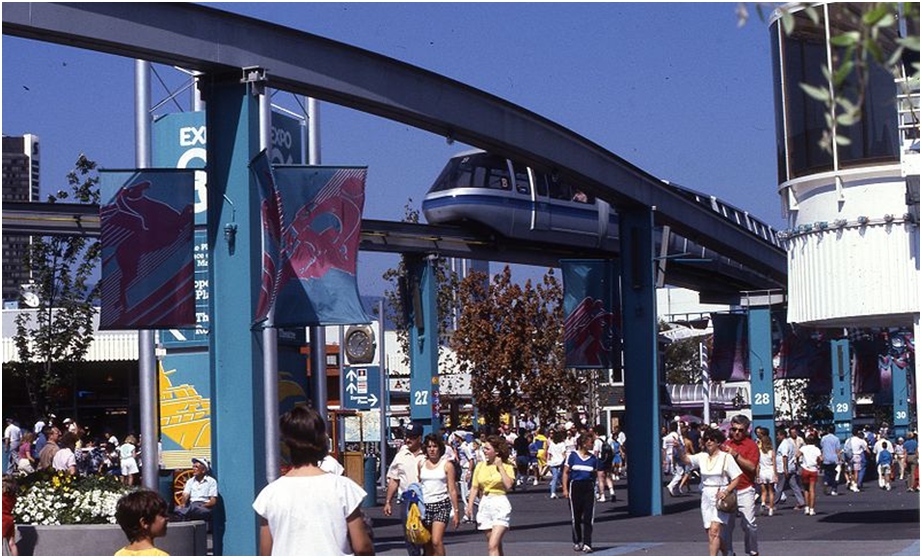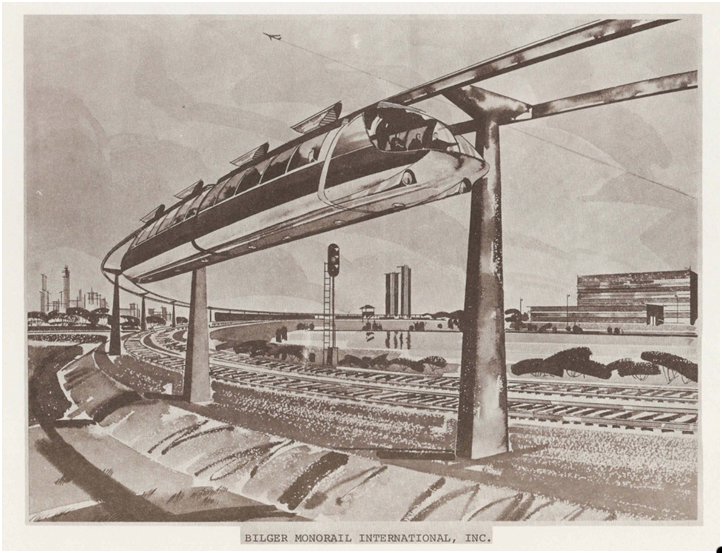Friday fun guest post: A history of monorails in Vancouver, by Michael Taylor-Noonan
Friday fun guest post: A history of monorails in Vancouver, by Michael Taylor-Noonan

I’m happy to welcome another guest post from Michael Taylor-Noonan, the newsletter editor for the Transit Museum Society! (He previously wrote guest posts about Vancouver bus numbers, and reminiscences of early Vancouver transit.) This time, Michael has kindly contributed a short history of monorails in Vancouver. Read on for more!
Readers old enough to remember EXPO 86 will certainly remember the monorail used for transporting visitors around the worlds’ fair site. That monorail, built by Von Roll of Switzerland, is still providing transportation, but now at Alton Towers theme park in the UK. It was installed there in 1987. During its one summer of operation, it was certainly the closest Vancouverites came to having a monorail as a permanent addition to the transportation network.
The idea of a monorail in Vancouver is certainly not new, though. You may be surprised to learn that there have been two proposals to build a monorail between downtown Vancouver and the airport. The first was in the mid-fifties when YVR (as it’s known today) proposed a growth strategy that reserved the airport for long-haul flights. Service to cities in B.C. such as Victoria, Powell River, and Kelowna would be by helicopter from a downtown heliport. Connecting the two would be a monorail. It would cover the 15km or so in ten minutes, and would include possible freight and mail service.
“The ingredients are already there”, airport manager Bill Inglis commented in a November 14th, 1957, Vancouver Sun article. He was referring to the city planners decision to set aside land at the east end of False Creek for a heliport. At the time the city’s transit was provided by a private company: B.C. Electric Railway Co. Ltd. (BCER). One of its’ vice-presidents, W.C. Mainwaring, was impressed with a monorail he had seen in Germany on a visit, and prepared a report for the company. It looked like the BCER would invest in the monorail. But the plans took a strange turn.
A noted Canadian expatriate engineer, Wells Coates, had recently returned to his homeland after spending most of his professional career in London, England. There he designed such items as door handles, a microphone for the BBC, and even a catamaran. But he was also was an accomplished architect. He was very interested in urban renewal, especially in the False Creek area, and this led to him being asked to submit a design for the proposed monorail. He dubbed his design the Monospan Twin-Ride System (MTRS). The cars were mounted on the rail in a revolutionary way: a central guideway carried the car attached on its side. From drawings it appears that MTRS would be a demand responsive system, much like that recently installed at London Heathrow airport (and featured recently in this blog). Small cabins would provide transport rather than long trains.
Subsequently though, BCER changed its mind about investing in a monorail. It decided to limit its involvement to providing the right-of-way. When Coates couldn‘t interest a manufacturer in the project, it was abandoned (footnote 1). Coates himself died of a heart attack in 1958 at the age of 63.

Some fourteen years later, a U.S. Engineer, Anson S. Bilger also proposed a monorail to the airport. But his idea envisaged it running from Waterfront Station. The routing would have been via West Boulevard and Arbutus Street. There would be four intermediate stops. Trip time would be 15 minutes, with a 10 minute base headway. Again, freight and mail would be carried to boost revenue. The cost was estimated at $35 million. As the Canadian Pacific right-of-way along the Arbutus corridor was still in operation at that time, the supporting towers would have to have been quite high. Bilger proposed paying CPR one cent per passenger for the air rights over the rail track. An artist’s rendition of the proposal reused an American publicity handout, replacing a freeway with the railway. Hence the strange looking neighbourhood the train is passing through.
Of course, both proposals remained on the drawing boards, and when an airport link was finally opened in 2009, it was far removed from the Arbutus corridor and far removed from a monorail. After EXPO 86 closed there was an idea to reuse the monorail for local transit in the West End. In the nineties I recall there was similar interest in relocating Seattle’s 1962 vintage ALWEG monorail to Vancouver. But these too remained ideas, suggesting perhaps, that monorails and Vancouver just don’t mix.
Footnotes
1. Wells Coates, A Monograph. Cantacuzino, Sherban (G Fraser , London, 1978).






I’m glad to see the Canada Line on Cambie. It’s 15 minutes closer to East side where the rider ship is stronger. Cambie has also has key employment and shopping destinations that you can’t find on Arbutus.
Sydney, Australia has had a rather well-known monorail since 1988, using the same Von Roll technology as the Expo monorail. It was never a great success and the government bought out the P3 operator of the line in March this year so it can be shut down and facilitate extension of light rail into the CBD.
That Expo 86 picture sure brings me back…I rode that Monorail many times during my visits to the fair.